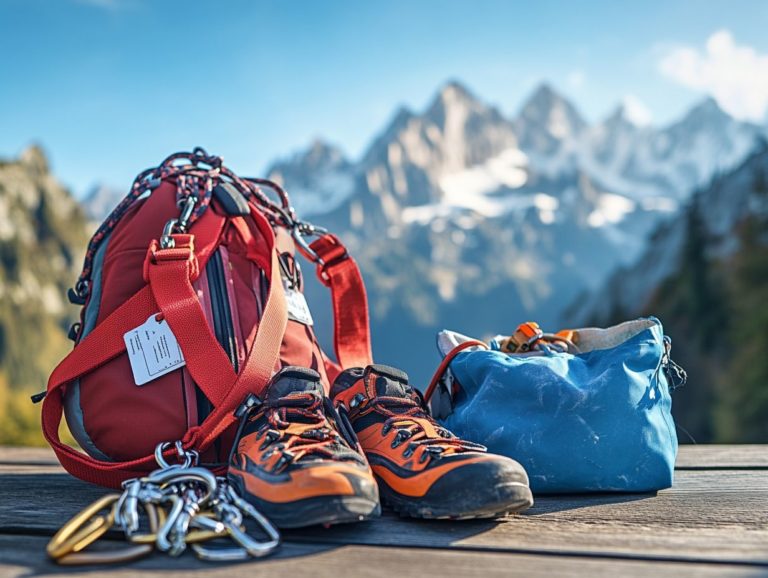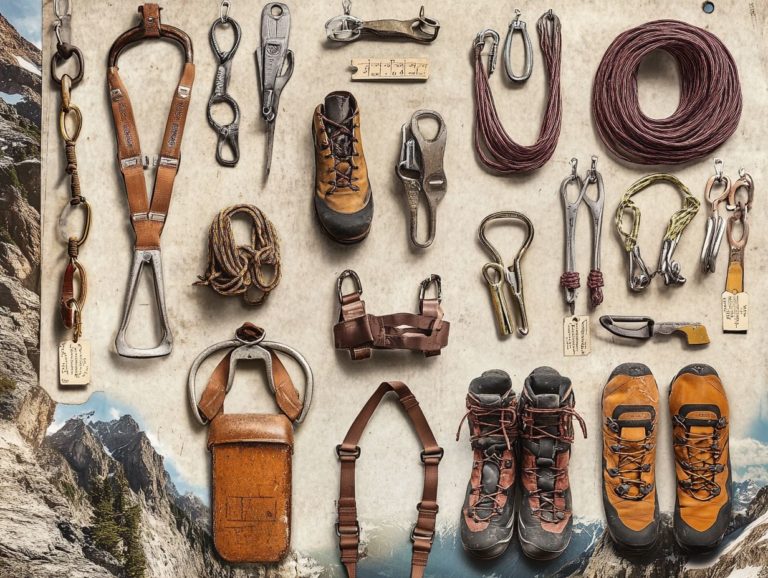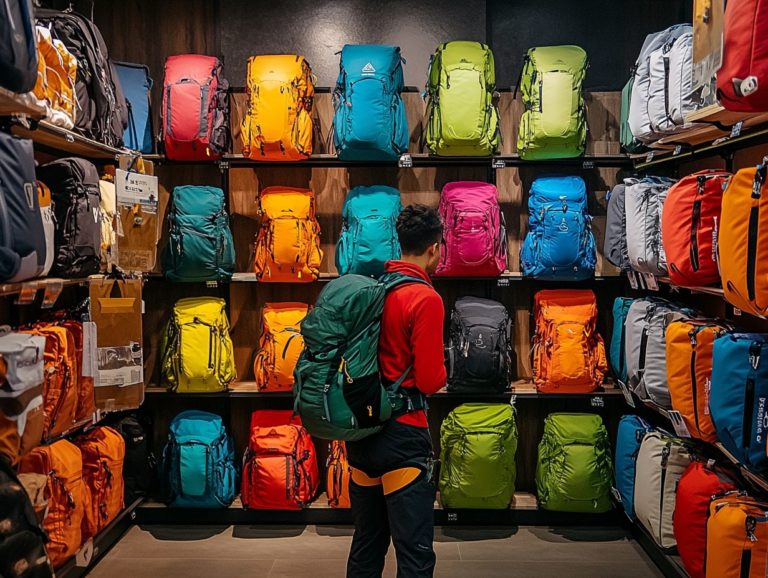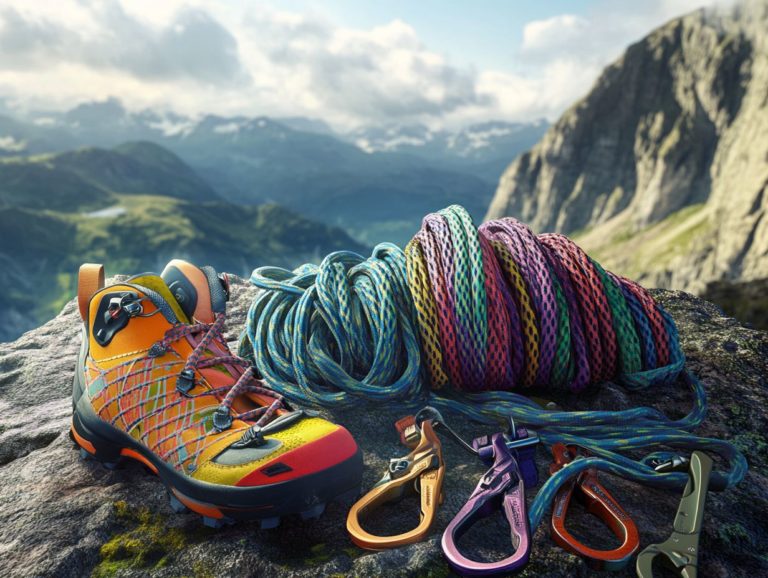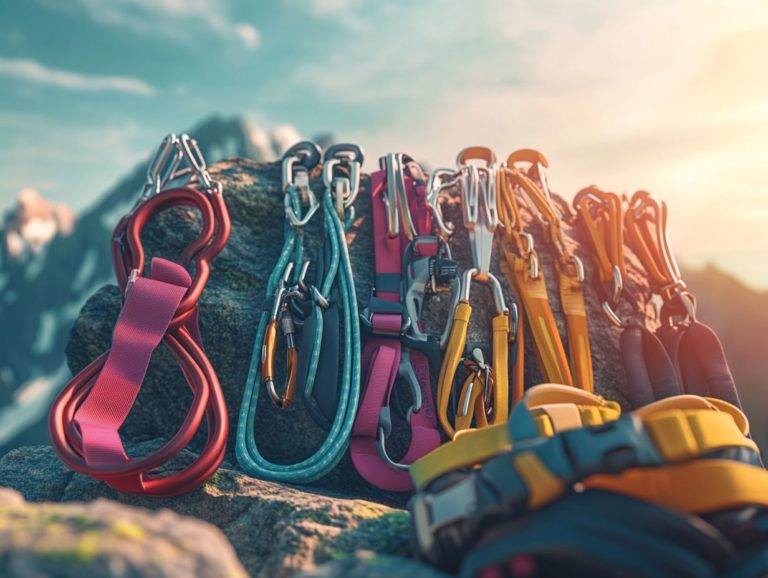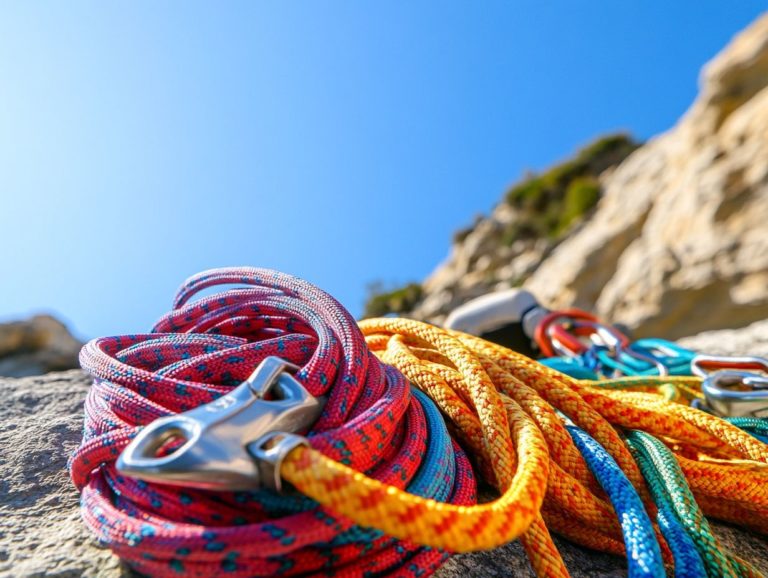Understanding the Different Types of Climbing Gear
Climbing is an exhilarating adventure. Having the right gear is crucial for safety and performance.
This guide explores different climbing equipment, including harnesses, climbing ropes, climbing shoes, and helmets. Each piece is designed to elevate your climbing experience.
You ll find insights on selecting the right gear tailored to your needs, focusing on fit and durability. You’ll also find useful tips for maintaining your equipment to keep it in peak condition.
Whether you re a seasoned climber or just starting, this information will empower you to navigate the world of climbing gear with confidence.
Contents
- Key Takeaways:
- Types of Climbing Gear
- Choosing the Right Climbing Gear
- Caring for and Maintaining Climbing Gear
- Frequently Asked Questions
- What are the different types of climbing gear?
- What is the purpose of climbing gear?
- How do I choose the right climbing gear for my needs?
- Do I need different gear for indoor and outdoor climbing?
- What are the main differences between sport and traditional climbing gear?
- Can I use old or secondhand climbing gear?
Key Takeaways:
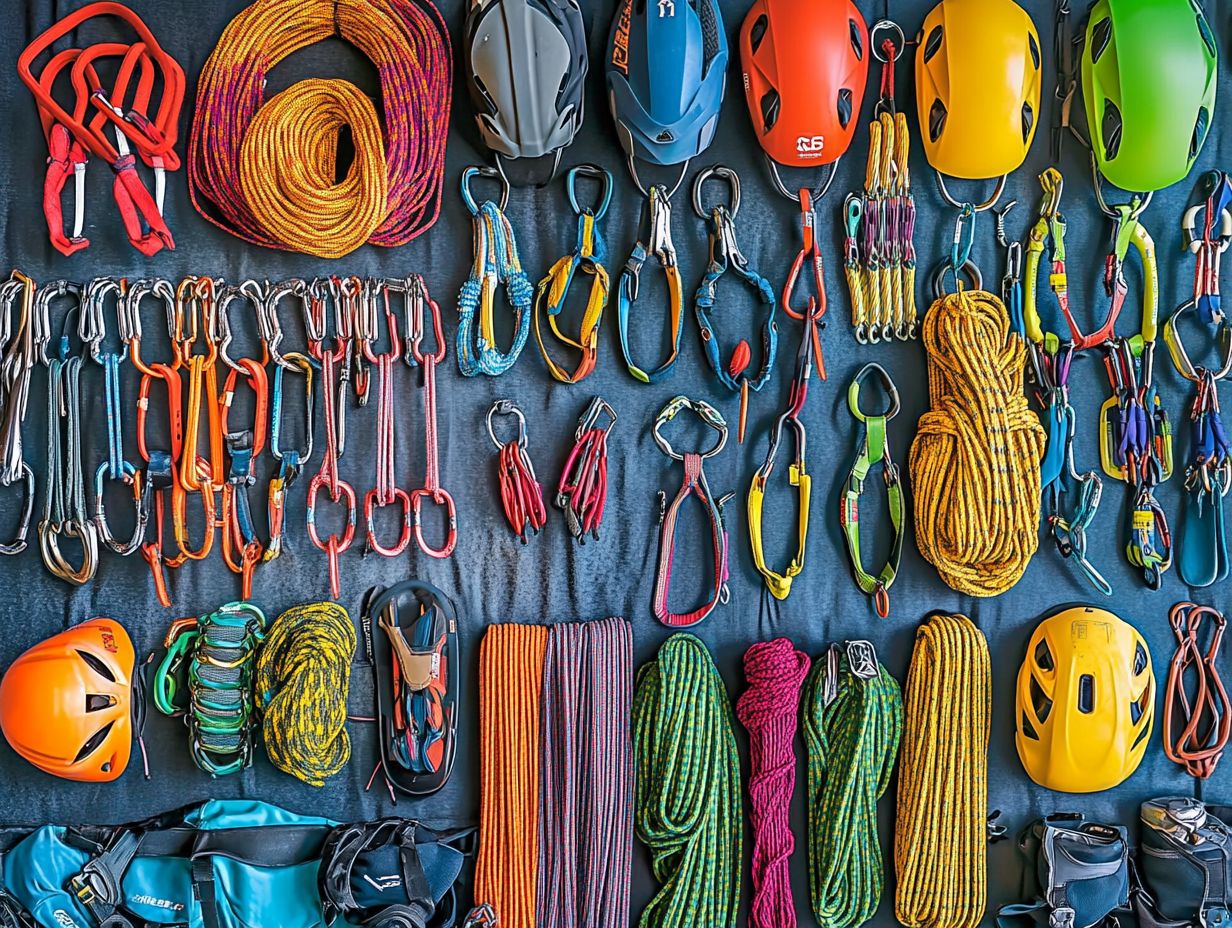
- Understanding the different types of climbing gear is crucial for a safe and successful experience.
- When choosing gear, consider your climbing type, experience level, and personal preferences.
- Proper care and maintenance of your gear is essential for its longevity and your safety.
What is Climbing Gear?
Climbing gear is essential equipment designed to improve safety and performance. It includes tools for various climbing styles like rock climbing, sport climbing, and mountaineering.
Harnesses connect you to the rope, while carabiners are metal clips that secure the ropes. Climbing shoes are designed for better grip and footwork, enhancing your climbing experience.
For instance, bouldering relies on crash pads for protection, while alpine climbing requires ice tools and crampons to navigate frozen surfaces. Choosing the right gear boosts your confidence and performance while ensuring safety.
Understanding how each type of gear functions is key to optimizing your climbing approach. This ensures every ascent is both enjoyable and safe.
Types of Climbing Gear
Climbing gear is incredibly diverse. It includes a range of equipment vital for safe and efficient climbing experiences.
Each gear category is designed for specific activities like sport climbing, traditional climbing, or bouldering. This allows you to tackle your routes with confidence.
From harnesses and ropes to tools like belay systems and crash pads, knowing the nuances of climbing gear is essential. This knowledge enhances your safety and elevates your performance in every climb.
Harnesses
A climbing harness is a key piece of gear that secures you and spreads out forces during a fall. It’s essential for climbing safety, allowing you to connect ropes and other gear.
There are various harness styles for different types of climbing. Sport climbing harnesses are lightweight and flexible, while traditional ones often have extra loops for gear. If you boulder, a minimalist design offers great mobility without sacrificing safety.
When selecting a harness, consider your skill level. Beginners may value more padded options for comfort during longer climbs, while experienced climbers often look for versatility and performance. Choosing the right harness enhances your safety and improves your overall climbing experience.
Ropes
Climbing ropes are important for your safety, designed to absorb fall energy while supporting you. You should know about two main types: dynamic ropes, which stretch, and static ropes, used for rappelling and hauling gear.
Dynamic ropes are ideal for climbing situations where falls can occur, like lead climbing and top roping. On the other hand, static ropes have minimal stretch, making them perfect for rescue operations or when secure anchor points are needed.
When selecting the right rope, consider key factors such as diameter, length, and intended use. Sport climbers often prioritize lighter ropes for easier handling, while trad climbers may prefer thicker ropes for added durability. Always consult expert recommendations to ensure safety and optimal performance.
Carabiners
Carabiners are essential connectors between your ropes, harnesses, and anchors. These strong metal loops come in different shapes and sizes, including locking and non-locking types for various climbing activities.
You ll find three main types: oval, D-shaped, and pear-shaped carabiners. The D-shaped one offers a great balance of strength and weight, making it ideal for quickdraws, which connect a rope to climbing protection, such as bolts.
The choice of carabiner impacts both your safety and climbing performance. Using a quickdraw properly facilitates smoother movement and aids rope management. It’s vital to consider the materials and locking mechanisms of your gear to ensure reliability under stress.
Climbing Shoes
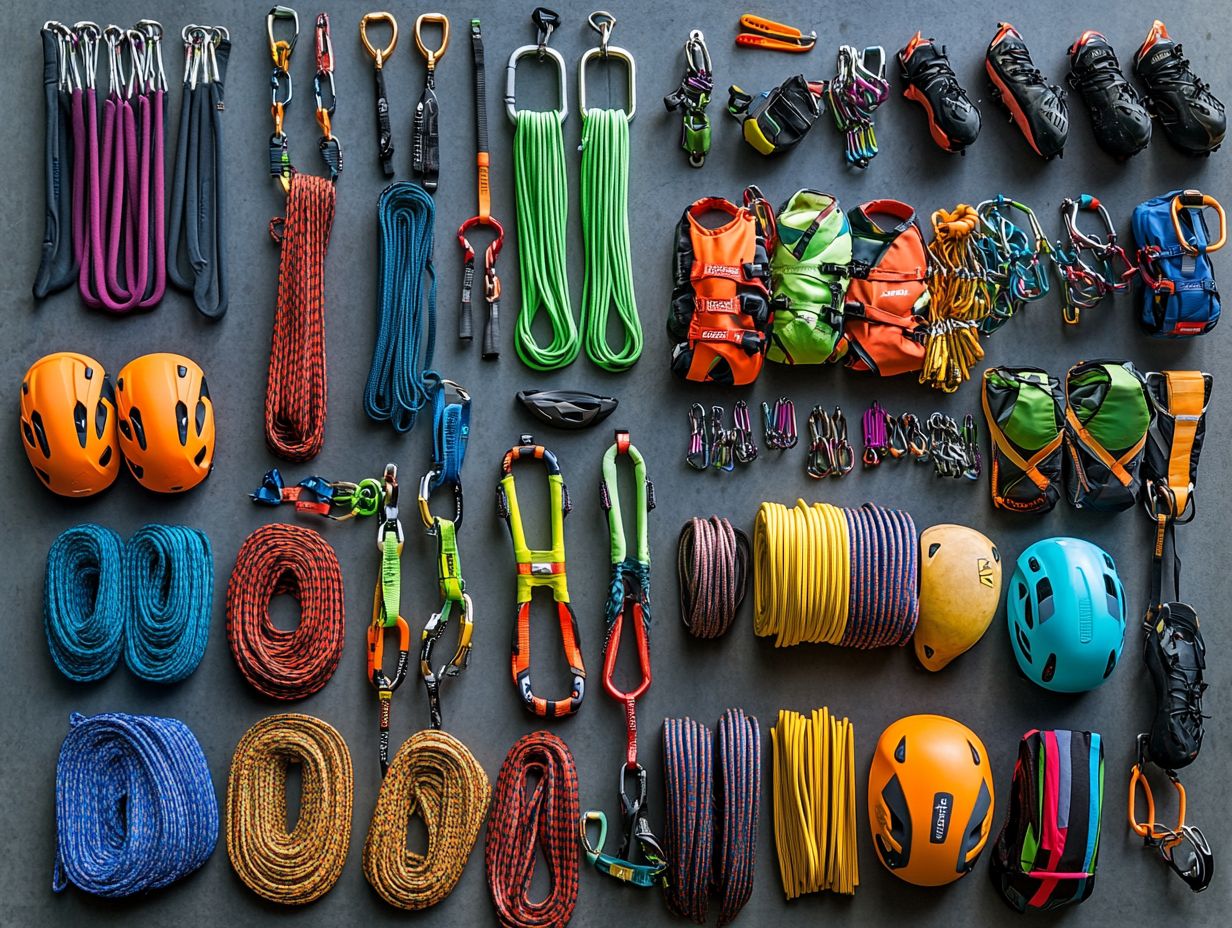
Climbing shoes are your secret weapon for conquering those heights! They are specially designed footwear that enhances your climbing performance. They offer great grip, support, and feel on various surfaces.
With an array of styles available from aggressive designs perfect for sport climbing to more comfortable options ideal for long days in traditional climbing the right pair can profoundly impact your technique and overall climbing experience. They are an essential component of your climbing gear.
When choosing climbing shoes, consider your unique needs. As a beginner, you might find that a more relaxed fit prioritizes comfort, allowing you to wear them longer during practice sessions. If you re an intermediate or advanced climber, you may prefer a tighter fit and the downward curve of the shoe’s toe helps with precision on your ascents.
Don t overlook material and closure systems, either; synthetic options bring durability, while leather offers a more natural fit that adapts over time. Ultimately, selecting the appropriate climbing shoes tailored to your specific climbing style can dramatically improve your safety and agility on the rock. Your next adventure awaits make sure you re equipped!
Climbing Helmets
A climbing helmet is a critical piece of safety gear crafted to shield your head from falling rocks, equipment, and impacts during climbing endeavors. These helmets are lightweight and durable. They often come with adjustable features for a snug fit, making them a wise investment for anyone venturing into outdoor climbing, tackling indoor walls, or embarking on any climbing adventure where the risk of head injury looms.
You ll find various types of climbing helmets, like hard-shell and foam models, tailored to different climbing environments and personal preferences. Hard-shell helmets provide exceptional protection from impacts, making them perfect for rock climbing, while foam helmets tend to be lighter and are better suited for sport climbing or indoor gym sessions.
Many helmets also boast ventilation systems that enhance comfort during those grueling climbs. You must consider the type of climbing you re pursuing to stay safe! Factors such as weight, fit, and safety certifications should inform your choice. Opting for helmets specifically designed for your climbing activity not only enhances your safety but also ensures a more enjoyable experience.
Belay Devices
Belay devices are vital tools for safe climbing. They help manage the rope during belaying, allowing you to ascend and descend securely.
These devices come in different styles, like tube-style and assisted-braking. Each is designed to enhance your safety and efficiency while climbing.
Understanding these devices is key to effective communication and safety with your climbing partner.
For example, tube-style devices, like the Black Diamond ATC, allow for smooth rope handling, making them great for sport and traditional climbing.
Assisted-braking devices, such as the Petzl GriGri, provide extra safety, which is especially useful for new climbers or in unpredictable situations.
Practicing proper rope management techniques is essential. Maintain a steady brake hand and stay aware of your climber’s movements.
Regular checks and good communication will help reduce accidents and improve your climbing experience.
Quickdraws
Quickdraws are essential components of your climbing gear, connecting the climbing rope to secured points on the rock and providing a strong, secure link.
Each quickdraw consists of two carabiners joined by durable webbing, allowing for quick and efficient clipping during your climbs.
Choosing the right quickdraw can significantly enhance your climbing experience. For instance, a lighter quickdraw is ideal for long ascents, while a more robust option might be necessary for strenuous routes.
When you clip the quickdraw, ensure the rope is positioned correctly in the carabiner to avoid accidental unclipping. Regularly inspecting your quickdraws for signs of wear or damage is vital to maintaining your safety standards.
Becoming familiar with different quickdraw styles can also make a notable difference in your performance. Some feature straight gates for easier clipping, while others have bent gates designed for quicker attachment to anchors.
Nuts and Cams
Nuts and cams are crucial for safety in traditional climbing. They secure you to the rock face, with nuts fitting snugly into cracks and cams expanding to adapt to various rock shapes.
Understanding how to use these tools effectively is key for climbers. Nuts are usually made of aluminum or steel, designed to fit parallel-sided cracks. Cams, with their clever design using flexible lobes, accommodate a wider range of shapes, making them perfect for unpredictable rock features.
For a safe and effective climb, pay close attention to how you place your nuts and cams. Proper placement ensures they hold securely, giving you peace of mind as you tackle vertical challenges.
Master these tools to enhance your climbing adventures!
Climbing Chalk
Climbing chalk is a specialized product designed to enhance your grip and reduce moisture on your hands. This significantly improves your climbing performance. Whether you re into sport climbing, traditional climbing, or bouldering activities where handhold grip is essential you’ll find that the right chalk can help you conquer challenging routes and enrich your climbing experience.
There are various types of climbing chalk available, each catering to distinct needs and preferences. For instance, magnesium carbonate chalk, a type of chalk made from magnesium that helps absorb moisture, reigns supreme for its exceptional qualities. On the other hand, liquid chalk offers quick application and lasting performance. You might also find chalk infused with additives, designed to provide extra grip or skin protection.
To maximize the benefits of climbing chalk, apply a controlled amount to your hands right before you begin your climb. This keeps your hands dry, optimizing your performance. By mastering proper chalk storage and application techniques, you’ll enhance your grip and boost your confidence as you tackle the rock face.
Choosing the Right Climbing Gear
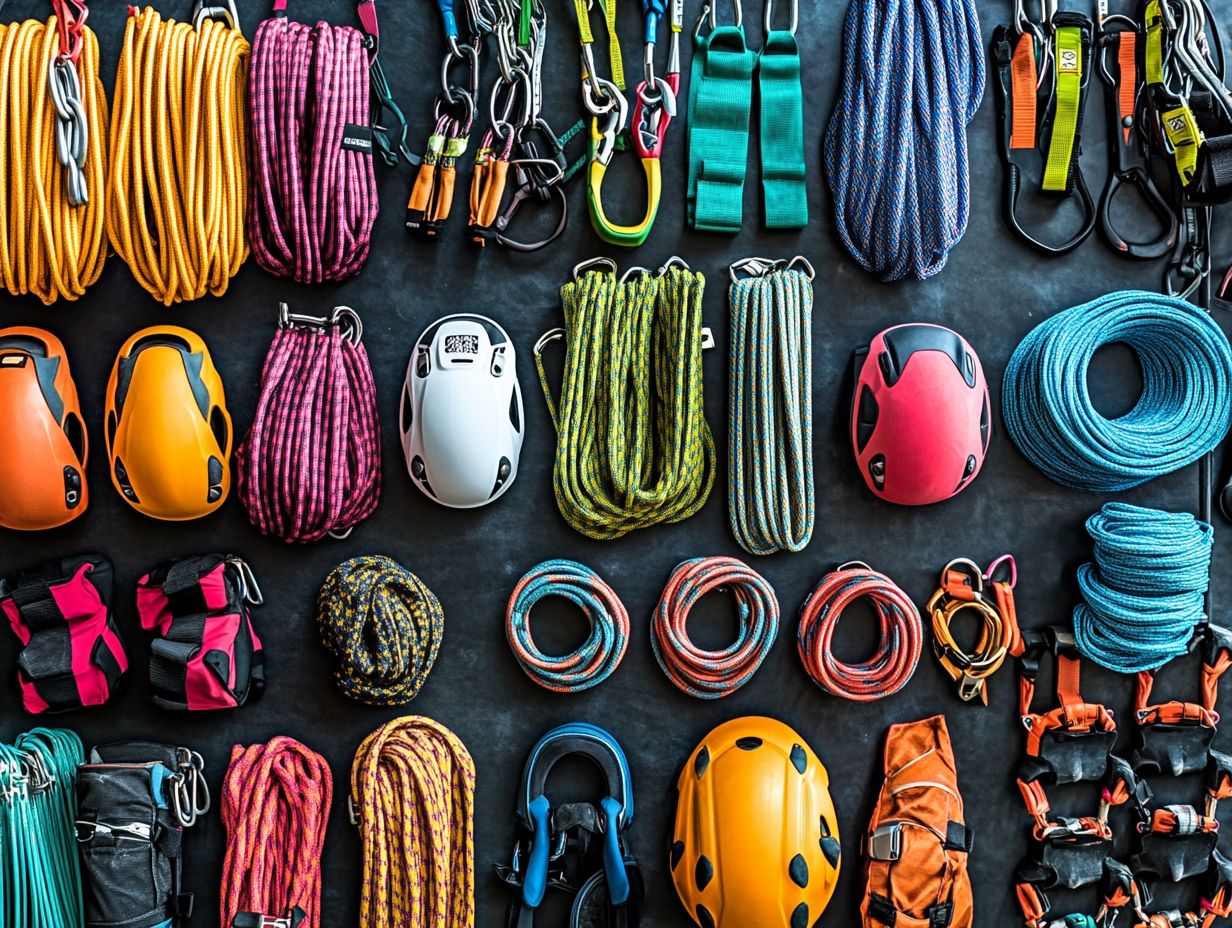
Choosing the right climbing gear is crucial for a safe and enjoyable adventure! Consider factors like the type of climbing you plan to do, your personal preferences, and the specific conditions you ll encounter when selecting your gear.
A solid understanding of the available climbing gear, combined with a grasp of climbing safety principles, can elevate your performance and enhance your enjoyment, paving the way for unforgettable climbing adventures.
Ready to gear up? Check out our recommended climbing equipment!
Factors to Consider
When selecting climbing gear, consider factors that impact your safety, performance, and comfort. Key aspects include the type of climbing you plan, the specific equipment you’ll need, and your individual skills.
Each climbing style bouldering, sport climbing, or traditional climbing requires specific gear that enhances safety and effectiveness. The fit of your gear is crucial; ill-fitting equipment can lead to discomfort and security issues.
Check the safety ratings on helmets, harnesses, and other gear. These ratings indicate how well your gear performs in different conditions.
Factors like rock type and weather also influence your gear choice. Understanding these aspects is your ticket to a thrilling and safe ascent!
Caring for and Maintaining Climbing Gear
Proper care of your climbing gear is vital for safety and longevity. This allows you to perform at your best during climbs.
Regularly inspect and clean your equipment like climbing ropes, harnesses, and helmets. This practice helps prevent accidents and ensures your gear meets safety standards.
Tips for Proper Maintenance
To ensure the longevity and reliability of your climbing gear, it s essential to regularly follow maintenance tips specific to each type of equipment, from climbing ropes to carabiners and harnesses. Proper cleaning, inspection, and storage extend your gear’s lifespan and boost your climbing safety. Adopt a consistent maintenance routine to safeguard your equipment and enjoy a more secure climbing experience.
Start by understanding how to clean your climbing ropes. Gently wash them by soaking in warm water with a mild detergent, avoiding harsh chemicals that could damage the fibers. For your climbing harness, check for any signs of wear or fraying; make it a habit to inspect the buckles and stitching to ensure they re trustworthy.
As for your climbing helmet, store it properly in a cool, dry place away from direct sunlight to prevent damage.
Stick to these maintenance tips to boost your gear’s performance and climb safer every time!
Frequently Asked Questions
What are the different types of climbing gear?
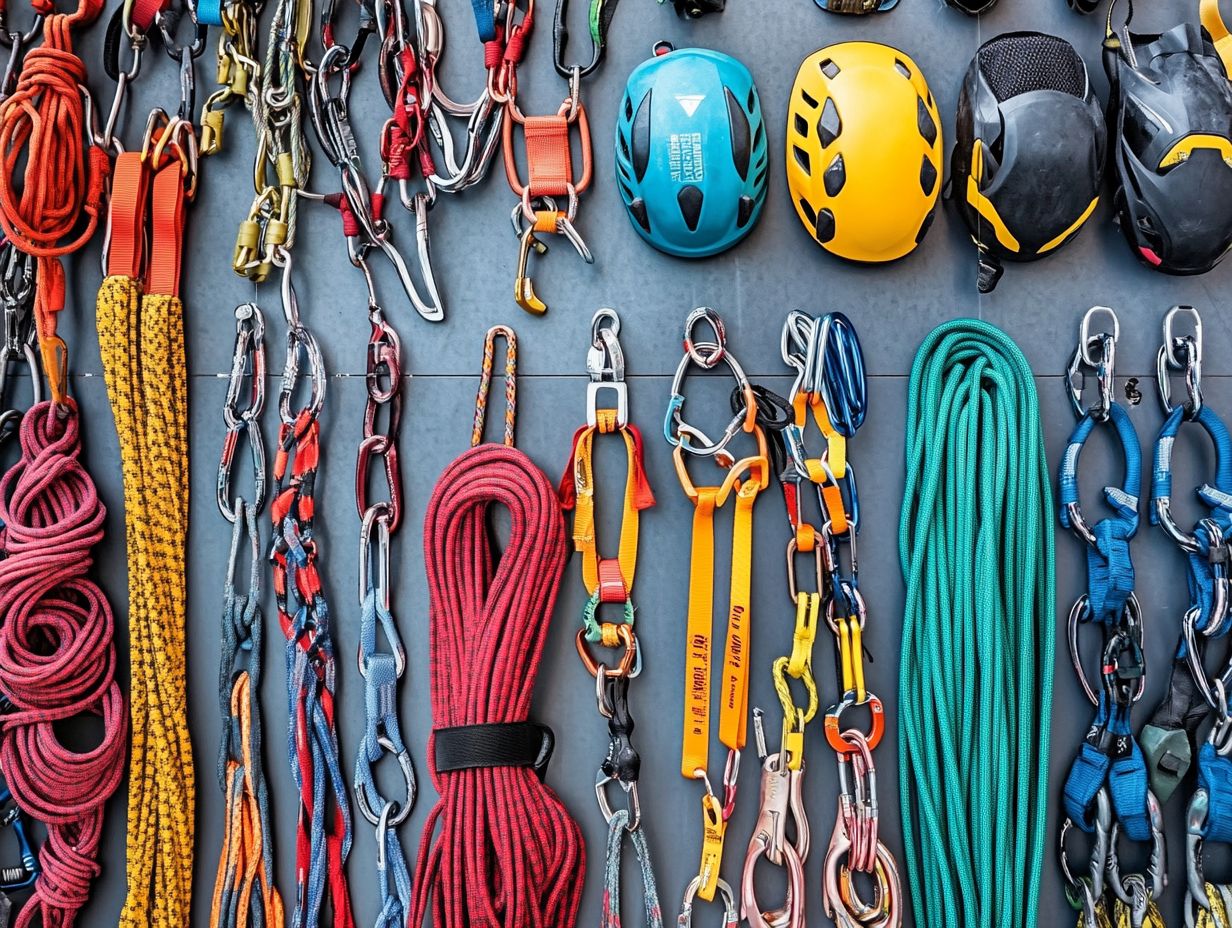
The different types of climbing gear include:
- Ropes
- Carabiners
- Harnesses
- Shoes
- Helmets
- Protection devices like cams and nuts
- Dynamic ropes
What is the purpose of climbing gear?
The purpose of climbing gear is to provide safety, support, and assistance while climbing. It protects against potential hazards and accidents, ensuring you have the right rock climbing equipment.
How do I choose the right climbing gear for my needs?
Choosing the right climbing gear involves considering:
- The type of climbing you will be doing
- Your level of experience
- The type of rock or terrain you will encounter
Whether you are interested in outdoor climbing or indoor climbing, make sure to select the gear that fits your needs.
Do I need different gear for indoor and outdoor climbing?
Yes, the type of climbing gear varies depending on whether you are climbing indoors or outdoors. For example, outdoor climbing may require specialized gear for protection against the elements, such as crash pads for bouldering.
What are the main differences between sport and traditional climbing gear?
The main differences between sport and traditional climbing gear lie in the type of protection used. Sport climbing uses quickdraws, while traditional climbing relies on nuts and cams for securing the climber.
Engaging with the climbing community and participating in events can greatly enhance your skills. For bouldering, crash pads are crucial for safety, as they help reduce the risks of falls.
It’s vital to include essentials like dynamic ropes (which stretch) and static ropes (which do not) in your climbing gear list. Quickdraws, also essential, help secure your climbing line.
Using a proper belay device and climbing carabiners is key for safe climbing activities.
Can I use old or secondhand climbing gear?
Avoid using old or secondhand climbing gear! Your safety depends on it. Items like ropes, harnesses, and helmets may have worn out parts that compromise your safety.
Regularly inspect and replace your climbing gear to ensure it is in good working condition. This is especially important for outdoor and indoor climbing activities.

